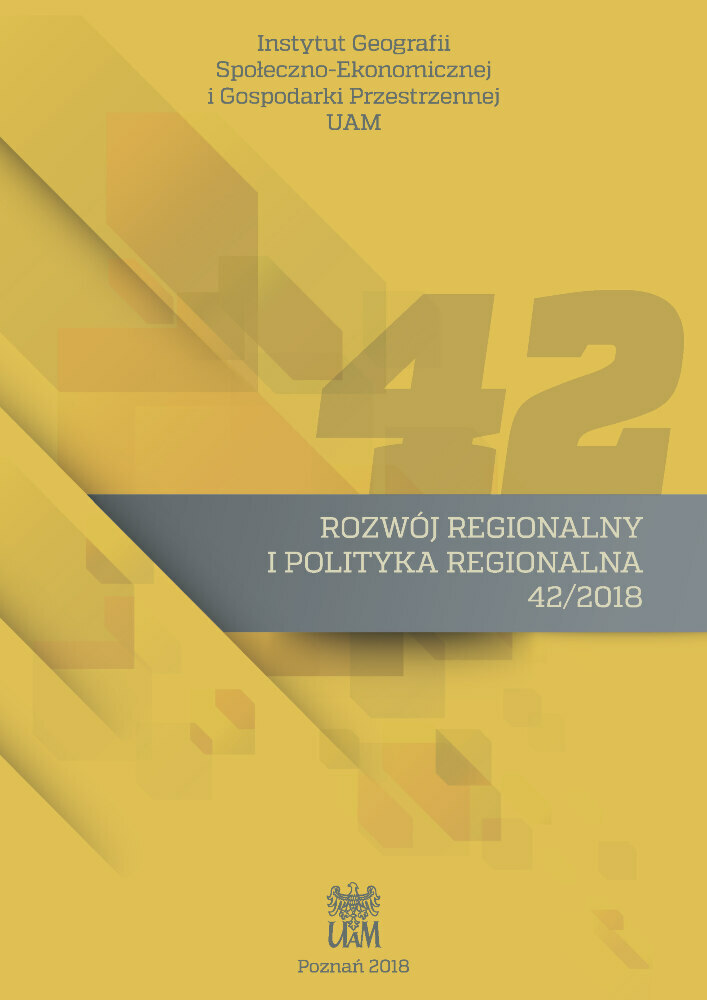Abstrakt
Pobudzenie transferu technologii jest jednym z priorytetów, jakie stawia sobie do realizacji Unia Europejska w kontekście rozwoju innowacyjności i konkurencyjności podmiotów gospodarczych. Instrumentem pomagającym realizować ten cel mogą być parki naukowo-technologiczne, które odgrywają coraz większą rolę w gospodarce opartej na wiedzy i przyczyniają się do zachodzenia istotnych przemian w środowisku innowacyjnym. Celem artykułu jest ukazanie ich roli jako instrumentu ułatwiającego zachodzenie procesów związanych z transferem technologii. Ostatnia sekcja opracowania przedstawia zasady działania Krakowskiego Parku Technologicznego.Bibliografia
Anderson T., Sjölund T. 2006. Engaging Science Parks and Incubators to Meet the Needs for Skill Upgrading in SME’s. Invited Paper for the 2005 IASP World Conference, Beijing.
Anttiroiko A.V. 2004. Editorial: Global Competition of High-Tech Centres International Journal of Technology Management, 28: 289–323.
Appold S.J. 2004. Research Parks and the Location of Industrial Research Laboratories: an Analysis of the Effectiveness of a Policy Intervention. Research Policy, 33, 2: 225–243. DOI: https://doi.org/10.1016/S0048-7333(03)00124-0
Blanc C., Simoens J.M., Bonmariage S., Thibaut S. 2004. How Do Science Parks of Wallonia Attract Companies through their Added Value Services? [W:] International Association of Science Parks (red.), Regional Attractiveness in the Knowledge Economy, Bergamo, s. 287–290.
Cassingena Harper J., Georghiou L. 2005. Foresight in Innovation Policy: Shared Visions for a Science Park and Business-University Links in a City Region. Technology Analysis and Strategic Management, 17, 2: 147–160. DOI: https://doi.org/10.1080/09537320500088716
Castells M., Hall P. 1994. Technopoles of the World, Routledge, London–New York.
Cohen W.M., Fjeld J. 2016. The Three Legs of a Stool: Comment on Richard Nelson The Sciences are Different and the Differences Matter. Research Policy, 45: 1708–1712. DOI: https://doi.org/10.1016/j.respol.2016.06.002
Cooke P. 2001. From Technopoles to Regional Innovation Systems. The Evolution of Localised Technology Development Policy. Canadian Journal of Regional Science, 24, 1: 21–40.
Engeln J., Gottschalk S., Rammer C. 2004. Location Decisions of Spin-Offs from Public Research Institutions, Industry and Innovation, 11, 3: 207–223. DOI: https://doi.org/10.1080/1366271042000265384
De Fuentes C., Dutrénit G. 2012. Best Channels of Academia – Industry Interaction for Long-Term Benefit. Research Policy, 41, 9: 1666–1682 (http://dx.doi.org/10.1016/j.respol.2012.03.026; dostęp: 18.04.2018). DOI: https://doi.org/10.1016/j.respol.2012.03.026
Guy I. 1996. A Look at Aston Science Park. Technovation, 16: 217–218. DOI: https://doi.org/10.1016/0166-4972(96)00002-8
Hołub-Iwan J., Olczak A., Cheba K. 2012. Benchmarking parków technologicznych w Polsce edycja 2012, PARP, Warszawa.
Knockaert M., Ucbasaran D., Wright M., Clarysse B. 2011. The Relationship Between Knowledge Transfer, Top Management Team Composition and Performance: The Case of Science-Based Entrepreneurial Firms. Entrepreneurship Theory and Practice, 35: 777–803. DOI: https://doi.org/10.1111/j.1540-6520.2010.00405.x
Konferencja Open Living Lab Days 2017 (http://krakow.pl/aktualnosci/211533,32,komunikat,konferencja_open_living_lab_days_2017.html; dostęp: 13.04.2018).
Krakowski Klaster Filmowy (http://www.film-krakow.pl/pl/#about-us; dostęp: 13.04.2018).
Krakowski Park Technologiczny, Biuletyn Informacji Publicznej (http://kpt.krakow.bip-e.pl/kpt/struktura-wlasnosciowa/6369,Struktura-wlasnosciowa.html; dostęp: 13.04.2018).
Krakowski Park Technologiczny (http://www.kpt.krakow.pl/; dostęp: 16.04.2018).
Lester R.K. 2005. Universities, Innovation and the Competitiveness of Local Economies. MIT Industrial Performance Center Working Paper, 05–010.
Link A.N., Scoot J.T. 2003. U.S. Science Parks: the Diffusion of an Innovation and its Effects on the Academic Mission of Universities. International Journal of Industrial Organization, 21, 9: 1323–1356. DOI: https://doi.org/10.1016/S0167-7187(03)00085-7
Löfsten H., Lindelöf P. 2001. Science Parks in Sweden – Industrial Renewal and Development. R&D Development, 31, 3: 309–322. DOI: https://doi.org/10.1111/1467-9310.00219
Löwegren-Williams M. 2000. Advantages of a Science Park Location: Case Studies from the Ideon Science Park. University of Lund.
Marszałek A. 2017. Główni aktorzy uczestniczący w transferze technologii towarzyszącym komercjalizacji wiedzy. Marketing i Rynek, 3: 12–23.
Massey D., Quintas P., Wield D. 1992. High Tech Fantasies: Science Parks in Society. Science and Space. Routledge, London.
Meyer-Krahmer F., Schmoch U. 1998. Science-based Technologies University-Industry Interactions in Four Fields. Research Policy, 27, 8: 835–851 (http://dx.doi.org/10.1016/S0048-7333(98)00094-8). DOI: https://doi.org/10.1016/S0048-7333(98)00094-8
Narasimhalu A.D. 2015. Building Effective Bridges between Science Parks and Universities. World Technopolis Review, 4: 2–10. DOI: https://doi.org/10.7165/wtr2015.4.1.2
Nauwelaers C., Kleibrink A., Stancova K. 2014. The Role of Science Parks in Smart Specialisation Strategies. JRC Technical Reports, European Commission.
Phan P.H., Siegel D. 2006. The Effectiveness of University Technology Transfer. Foundations and Trends in Entrepreneurship, 2, 2: 77–144. DOI: https://doi.org/10.1561/0300000006
Rosenberg N., Nelson R. 1994. American Universities and Technical Advance in Industry. Research Policy, 23, 3: 323–348 (http://dx.doi.org/ 10.1016/0048-7333(94)90042-6). DOI: https://doi.org/10.1016/0048-7333(94)90042-6
Scale UP (http://scaleup.kpt.krakow.pl/; dostęp: 16.04.2018).
Shearmur R., Doloreux D. 2000. Science Parks: Actors or Reactors? Canadian Science Parks in their Urban Context. Environment and Planning, 32, 6: 1065–1082. DOI: https://doi.org/10.1068/a32126
Siegel D.S., Westhead P., Wright M. 2003. Science Parks and the Performance of New Technology-Based Firms: A Review of Recent U.K. Evidence and an Agenda for Future Research. Small Business Economics, 20: 177–184. DOI: https://doi.org/10.1023/A:1022268100133
Spithoven A. 2015. Technology Transfer as a Driver for Location of R&D Active Firms on Science Parks. Int. J. Innovation and Regional Development, 6, 1: 80–101. DOI: https://doi.org/10.1504/IJIRD.2015.067647
Squicciarini M. 2008. Science Parks’ Tenants versus Out-of-Park Firms: Who Innovates More? A Duration Model. Journal of Technology Transfer, 33, 1: 45–71. DOI: https://doi.org/10.1007/s10961-007-9037-z
Teirlinck P., Spithoven A. 2008. The Spatial Organisation of Innovation: Open Innovation, External Knowledge Relations and Urban Structure. Regional Studies, 42, 5: 689–704. DOI: https://doi.org/10.1080/00343400701543694
Ustawa z dnia 27 lipca 2005 r. Prawo o szkolnictwie wyższym (Dz.U. z 2012, poz. 572, 742, 1544 z późn. zm.; http://www.bip.nauka.gov.pl/ustawy-akty-sw/ustawa-z-dnia–27-lipca–2005-r-prawo-o-szkolnictwie-wyzszym-tekst-ujednolicony.html; dostęp: 1.11.2017).
van Praag C., Versloot P. 2007.What Is the Value of Entrepreneurship? A Review of Recent Research. Small Business Economics, 29: 351–382. DOI: https://doi.org/10.1007/s11187-007-9074-x
Vilà P.C., Pagès J.L. 2008. Science and Technology Parks. Creating New Environments Favourable to Innovation. Paradigmes: 141–149.
Westhead P., Storey D.J., Cowling M. 1995. An Exploratory Analysis of the Factors Associated with the Survival of Independent High-Technology Firms in Great Britain. [W:] F. Chittenden, M. Robertson, I Marshall. (red.), Small Firms: Partnerships for Growth. Paul Chapman, London.
World Bank 2015. Doing Business 2014: Understanding Regulations for Small and Medium-Sized Enterprises (http://www.doingbusiness.org/reports/global-reports/doing-business-2014; dostęp: 10.04.2018). DOI: https://doi.org/10.1596/9780821399842
Wdrażanie innowacji przez szkoły wyższe i parki technologiczne 2012, LBI-4101-08-00/2012, Najwyższa Izba Kontroli (https://www.nik.gov.pl/plik/id,5291,vp,6860.pdf; dostęp: 17.04.2018).
Licencja
Copyright
© 2018 IGSEiGP, Uniwersytet im. Adama Mickiewicza w Poznaniu
OPEN ACCESS
